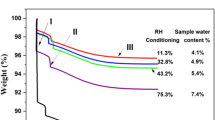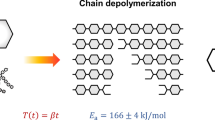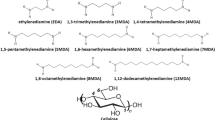Abstract
Formation of an activated cellulose (Cellulose) species
is the designated first stage of cellulose degradation in air [1]. Little is known about either the process or the nature of CELLULOSE*. The transition, designatedT 2, is observed as an exotherm around 300°C as the sample temperature is raised. No corresponding endotherm is observed on cooling. The process is therefore not reversible but is repeatable as subsequent reheating results in the exotherm being observed again. The exotherm is also found to be oxygen dependant. The effect of all the flame retardant treatments studied was to reduceT 2 compared to the value for the untreated cotton.
Zusammenfassung
Die Bildung aktivierter Zellulose aus Zellulose in Gegenwart von Wärme und Luft ist der ermittelte erste Schritt des Abbaues in Luft [1]. Über Prozeß und Natur von aktivierter Zellulose ist nur wenig bekannt. Die mitT 2 gekennzeichnete Umwandlung ist bei 300°C exotherm, wenn die Probentemperatur steigt. Beim Abkühlen wird keine entsprechende endotherme Erscheinung beobachtet. Der Prozeß ist somit nicht reversibel, jedoch bei nachfolgendem Wiedererhitzen wiederholbar. Die exotherme Erscheinung ist weiterhin sauerstoffabhängig. Der Einfluß aller untersuchten flammenhemmenden Behandlungen besteht in einer Reduzierung vonT 2, verglichen mit dem Wert von unbehandelter Baumwolle.
Similar content being viewed by others
References
A. A. Faroq, D. Price, G. J. Milnes and A. R. Horrocks, Polymer Degradation and Stability, 33 (1991) 155.
UK Fire statistics, HMSO, London, U.K. 1988.
A. R. Horrocks, J. Soc. Dyers and Colourists, 99 (1983) 191.
D. Price, A. R. Horrocks and M. Tunc, Chem. Brit., (1987) 235.
F. S. Kilzer and A. Broido, Pyrodynamics, 2 (1965) 151.
A. G. W. Bradbury and F. Shafizadeh, J. Appl. Sci. 22 (1978) 497.
D. Price, A. R. Horrocks and M. Akalin, Anal. Proc., 27 (1990) 148.
T. Hirata, ‘Pyrolysis of Cellulose, an Introduction to the Literature’, U.S. Department of Commerce, National Bureau of Standards, 1985.
Y. Ogiwara, N. S. Hon and H. Kubota, J. Appl. Polym. Sci., 18 (1974) 2057.
N. S. Hon, J. Appl. Polym. Sci., 13 (1975) 1933.
Author information
Authors and Affiliations
Rights and permissions
About this article
Cite this article
Price, D., Coleman, G.V. & Horrocks, A.R. Use of cyclic differential scanning calorimetry. Journal of Thermal Analysis 40, 649–656 (1993). https://doi.org/10.1007/BF02546636
Published:
Issue Date:
DOI: https://doi.org/10.1007/BF02546636




